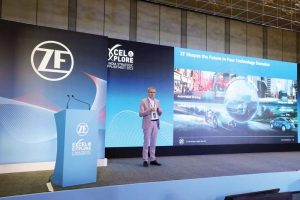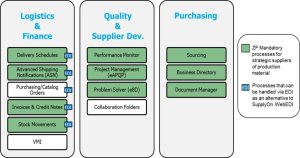In an Industry Talk session, Joerg Schaupp, Senior Vice President at ZF Group, Global Commodity and Purchase speaks to Ashish Bhatia about the checkpoints for a clear road map.
Q. How buoyant are you on the India growth sentiments? Given that you have a global outlook, how does it translate to the ZF go-to-market strategy?
 A. We are very excited to be in India to share the success story from a technical point of view. I work in the materials management team but overall represent the company and we are very excited of course, to have gone through the strategic acquisition overall with WABCO, which is now a part and an integrated Commercial Vehicle Solutions (CVS) division for the overall commercial vehicle segment at a Group level. For the materials management team, we are supporting overall businesses and very specifically the CVS business. The truck and trailer market is an overall growing segment for us. Our strong baseline and foundation here in India helped us jump on board in the global markets. So we are very happy to have a main successful supply base here and interactions with strategic suppliers, they would be held, to strengthen our position in the market.
A. We are very excited to be in India to share the success story from a technical point of view. I work in the materials management team but overall represent the company and we are very excited of course, to have gone through the strategic acquisition overall with WABCO, which is now a part and an integrated Commercial Vehicle Solutions (CVS) division for the overall commercial vehicle segment at a Group level. For the materials management team, we are supporting overall businesses and very specifically the CVS business. The truck and trailer market is an overall growing segment for us. Our strong baseline and foundation here in India helped us jump on board in the global markets. So we are very happy to have a main successful supply base here and interactions with strategic suppliers, they would be held, to strengthen our position in the market.
Q. In the post Covid-19 era, how are you ensuring profitability? How are you linking it with the Euro two billion sourcing plan?
A. You are right, the cash and profitability impact the bottom line. They need to be monitored very closely. And you can only spend nowadays as per your bottom line. So, we need to ensure a tight management and this is what we did actually. The markets are so volatile. They have changed from fixed 12-month planning into a monthly rolling. It is very important what we have done from a Group point of view. It is, for this reason, we are asking all suppliers to be cautious about the market dynamics and the direct impact in a lot of aspects from a global point of view. From a regional point of view as well. As a result, we want to ensure we make the right investments, where it matter, of course, right under competitive aspects to stay as envisioned.
We would like to grow in a certain market segment and with whom would we like to grow! So, which strategic suppliers are we forming alliances with to a geo-targeted sourcing approach say these suppliers have been proven of how they manage their business and are entering with us to a new level. We would like to do this locally, but as well as globally. It is from this perspective that we would like to reward our suppliers for this growth path of having a great export opportunity as well. The Indian supply base is ready for the next move, so to speak. Everybody understands the local needs, and the local demands, but it was encouraging to see that a lot of suppliers are ready for opportunities from export per se from India, but as well going forward to meet the localisation needs, where strategic moves make sense.
Q. The erstwhile time span on the near-term, medium-term and long-term time lines has changed. What is your take on the shrinking periods in consideration?
A. Overall, it’s a ramp-up, and you need to have a long-term vision. But you need to ensure some checkpoints in between short and mid-term as well to decide if I am on track or do I need to make some tweaks? I think, overall, with the right partners, you can have everything mapped out. So it’s not the conflict per se, that you only need to have some checkpoints in between, to ensure that you’re still on track.
Q. Have the dynamics of the core and non-core revenue streams altered?
A. We are checking this carefully because overall how we are positioning the company going forward, we need to make carefully planned strategic moves as well. What we considered core in the past, maybe not be core going forward. And hence, we are looking for a strategic partner, who can take over what we then consider non-core. I can give you an example. In the past stamping operations, and aluminium die-casting operations were partially as well core business points. Now we are saying no, going forward, this will be non-core. And that is where we need to have the strategic supply base in motion to support our new stance.
Q. How are you tackling growing electronic content per vehicle and the coexistence of multiple zero-emission solutions over just
electric. It calls for significant custom offerings as well?
Does it have a direct bearing on commodity consumption?
A. Overall, we need to have a lot of flexibility, because a lot of it’s in flux. It’s coming back to this point, that overall, we don’t have to fix the plan anymore. We need to have options and we need to work in scenarios. So we need to say, if one scenario comes with a certain acceleration rate that requires a fulfilment then we need to have the supply base for it. There needs to be another layer of flexibility besides other means if it were to change again over time.
Q. How are you dealing with commodity prices? There has been a level of fluctuation and the supply chain bottlenecks haven’t made it easier either. Have you had to pass through to the customer?
A. Overall, this is a very sensitive topic. To begin with, the crisis part, where the capacities, mainly on the semiconductors, we had partially over 100 people working as a task force for the whole ZF Group to ensure a well-oiled supply chain. To be frank, a very painful exercise on the whole. Happening through the downsising of Covid-19. To ensure fulfilment in the overall supply chain, maintaining enough capacity, and then the capacity was sold to somebody else. On this front, we are out of the ditch with still some aspects to work on. But on the horizon, you see that the capacity utilisation and the additional capacity are coming on stream, so
to speak.
When it comes to passing through, all the dynamics in the raw material markets, there’s a clear expectation from our customer base, that we find ways to compensate partially these increases. That’s a clear expectation from all stakeholders in the truck and passenger car industry. They expect us to find ways to mitigate it and to shift to having ‘Sharing Agreements’. We’re looking forward to there being a clear commitment from our supply base to find ways to mitigate the impact for the end customer very clearly.
Q. Are the operating margin pressures subsiding?
A. You need to make investments in this transformation of our industry and we are transforming mobility to realms like autonomous driving. We as ZF have defined before technologies mature, predominantly the big investments even when we did not see revenue streams coming up soon enough. We have invested roughly, seven to eight per cent of our overall sales into R&D. So there’s a huge commitment from ZF. Having said that and being the technology leader means investing up front. This, of course, causes enormous pressures on the bottom line margin.
Q. What’s been the boon and bane of global trade dynamics?
A. Well, there is big politics here, and we tried to stay out of this because we cannot influence the political will. We need to balance of course, between absorbing the risk and making our supply chains more robust. Of course, we’re looking to get everything in line when it comes to risk mitigation, as well as to have, overall cost competitiveness. I see a great opportunity for the total Indian supply base, to position them very strongly. This is where I see some big potential and advantages from the Indian supply base.
Q. How are you leveraging your strengths with multiple CoEs in India for meeting the domestic demand as well as positioning India as the global front?
A. We are bringing more and more technical expertise to the local market. Because the local demands and needs are partially different. We’re looking, of course, from a global standard perspective, but then making the application towards the local needs. This is what we need to balance as well with local engineering teams and zones.
Q. Do you consider India nearing a tipping point for it to significantly contribute to your global capabilities? Is it too early for it?
A. No, it has been accelerated, I must say, and I’m very positively surprised. Not positively just from a technology point of view, from a manufacturing point of view, and a civil commitment point of view. But this is very important because the ZF Group would like to be at the forefront of being sustainable. The Indian supply base has shown and demonstrated to me they take this by heart, and they’re ahead of the game in a lot of instances.
Q. In your opinion, is there a level playing field between the OEMs and the suppliers? What is your take on it as a leading supplier yourself?
A. In terms of giving a helping hand, yes. On the terms and conditions of your agreements, and supplier agreements as well, we could take more. There’s a huge demand. And we need to make it clear. Our expectation stems from customer needs and end-to-end transparency on customer demand and customer expectations are crucial. This is what we are streamlining right now, to be very clear on all aspects from a competitive point of view, a quality point of view, a logistic point of view, a sustainability point of view, and everything apart, end to end.
Q. How are you aligning with the government interventions and the new sectoral compliances that are being mandated? While good from the long-term perspective, do you fear any teething issues?
A. Together in the industry, we make sure that the government understands where they need to support us. Fundamentally, I think India is taking the right step forward to support those industry needs. For example, on the raw material side. How can the overall Indian industry automotive industry perform globally, if I don’t have the right raw material availability from a steel point of view, but from other raw materials as well. There are activities ongoing to see this through end-to-end because I cannot import steel globally, then manufacture and then export it again. This doesn’t make sense. The Indian government needs to think about the end-to-end cycle and ensure with the right moves, that the whole industry has the availability of everything that is needed.
Q. How do you look at the gap between the emerging markets and the more advanced and developed markets?
A. Big time! Therefore, we are here to encourage our supply base to take this step. It’s not just a local market, it’s a global market. And they compete and we had a lot of really interesting discussions about going outside of the local market to take the steps needed to have a strong path. You would like to be a strong partner to provide opportunities as well outside of India.
Q. In commercial vehicles, we are in a cyclical upturn. Will this upturn be sustained? Will the cycle continue to be predictable?
A. Overall, I think the cycle remains right. If it’s changing or not changing, it’s hard to predict overall. So, therefore, we are trying to strike a balance in our overall supply base in this perspective of encouraging as well to have the desired balance in the supplier exposure whether operating with us or with others. For example, we have a clear strategy, we are focusing on three segments, the passenger car, the CV segment, and the industry really to balance this out a little bit because dependency on one or the other is never expected to pan out perfectly. Otherwise, you only have the chance to flex, and that is what we need to learn as well. That is why we’re working heavily with our supply base.
Q. India is a largely cowl-driven CV market. As OEMs commit themselves to fully built solutions on the truck and bus side, how are you leveraging that momentum and also addressing any pain points for OEMs looking to scale it up?
A. So overall, we see this trend, of course, globally. Now, because we have new entities, which are looking for system providers. So the capabilities of our supply base are going up on the scale. There’s a huge opportunity to scale up from a pure product and parts manufacturer to become an assembly or pre-assembly, assembly and system provider as well. Because again, the OEMs truck industry or passenger car, they’re looking forward, for them to concentrate on their transformation. They need to have the whole supply chain stepping up one level in the overall chain.
Q. As you step up your capabilities, and you now progress to offering transport solutions over just parts, what has kept you from turning into a vehicle OEM yourself?
A. We are not going to turn it away and by what we are doing, we don’t want to interfere with our current customer base. This is a clear strategy and that’s very important. For instance, at the Consumer Electronics Show (CES) in Las Vegas, our autonomous shuttle is something that we are progressing with only because these segments are very important from a sustainability point of view to us and we would like to go beyond and contribute. It will in our opinion help solve some global issues.
Q. What are the current focus areas on offering safe, sustainable and digitised transport?
A. Well, for safe we have our overall clear technical domain where we say integrating safety is one area where we offer a full product range overall, in all segments, we operate in. All mobility solutions are offered by ZF for the next-generation mobility strategy to be implemented. So we have whole solutions, it’s just a matter now that the customer is picking up or seeing how to plug and play from all the available options.
Q. How are you optimising commodity procurement, capacity utilisation and augmentation at a global scale given the vast array and requirements of your interest, target markets?
A. We know the one pathway. So we take some planning premises, and what we have learned is to say first, not a fixed 12 months planning premise, which is an operational planning. In the normal means, we have learned now to go on a rolling adaption of this operational model. And then on top, we are operating in scenarios. So every month we’re looking actually on staying in the plan for 12 months or a longer horizon. Where is it going to be an optimistic or pessimistic scenario to have the right counter measurements in place?
Q. Have you started seeing results trickling in from your acquisitions like TRW and more recently WABCO, each a mammoth exercise? How do you expect JVs and M&A activity to fuel your growth strategy going forward?
A. Historically also we have grown with acquisitions. And I think both moves that you mentioned here, have brought us clearly into the segment of electronics, really a stronghold into the positioning of connecting all our systems. For instance, TRW was one of the cornerstones to bring us the inter connectivity of all the systems. In vehicle motion control, where we combine the shock-absorbing business, and the braking businesses doing business together with the domain ECU and control it all. The acquisitions have given us the ability now to be assisted providers, by all means for all of our truck and trailer customers. Without these, we wouldn’t be able to step up and provide one fit for all solutions.
Q. How do you expect the PLI scheme in India to play out over the next half a decade? What is the push for further localisation of products at your end?
A. There’s a 100 per cent need for localisation. But overall, we need to ensure now that we have the right raw materials, for example, in the market, and that is where we need to have the overall full admin support the same as in the case of electronics. With the wind business and other verticals supporting sustainability as well. There’s also a need to maybe tweak the overall programs of the government for the industry to be successful. We may come back with a finer outlay on that one in days to come and share it.
Q. What efforts are improving quality and delivery performance?
A. We are expecting our suppliers to check the new supplier audit. That will make sure, before we enter a relationship with the new supplier, he or she fulfils a base set of the group code. At the level of logistics and sustainability and so on. Of course, our existing supply base, we have developed and continuously with strong supply development activities here in India. We have a clear subset of robust processes, certificates and systems in place, as part of the new supplier audit being performed. So that suppliers doing business have clarity. For the existing supply base on top, they have a continuous improvement program in place with a strong supply development management team here, on-site, in India.
 Q. How important is the aftermarket at a Group level?
Q. How important is the aftermarket at a Group level?
A. I only can say aftermarket is a very important business for today as a group because we would like to be a full-service provider. From ramping up sops and then serving our customers, because it’s very important, especially in the commercial vehicle side of business, to have a reliable partner as well in the aftermarket business. Since I don’t oversee it directly, I cannot go deeper.
Q. To sum up, how are you gearing for the future?
A. Well, the challenge area is to get across to the Indian supply base, and realise how big the potential is not only for us but out there. I think that’s the biggest challenge. We have been very busy managing capacity shortfalls, the new market dynamics when it comes to sustainability, and so on, that we find the time to be the ambassador for all our suppliers, who would like to step up for the opportunities on the global scale. In the past, there was a fixed planning parameter. There was a fixed volume and a fixed raw material that made life a wee bit easier. Now it’s all dynamic. And we need to juggle all these dynamics and find the time to guide our suppliers. What is the right technology to invest in the future partnership? And that’s a struggle, a challenge that we are up for.





















